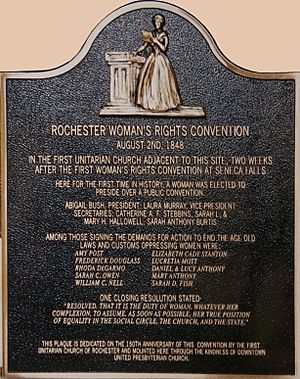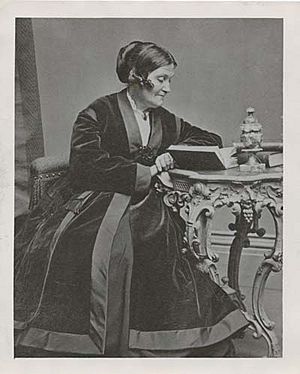Rochester Women's Rights Convention of 1848 facts for kids
The Rochester Women's Rights Convention of 1848 was a very important meeting held on August 2, 1848, in Rochester, New York. Many people who helped organize it had also been at the Seneca Falls Convention just two weeks earlier. The Seneca Falls meeting was the first-ever convention about women's rights.
At the Rochester convention, Abigail Bush was chosen to lead the meeting. This was a big deal because it was the first time in the U.S. that a public meeting with both men and women was led by a woman. Some people, even important leaders, thought this was too risky. The convention agreed to use the Declaration of Sentiments, which had been introduced at Seneca Falls. This document included the bold idea that women should have the right to vote. The meeting also talked about the rights of women who worked and helped start a local group to support them.
Many organizers of the convention were Quakers who had joined the First Unitarian Church of Rochester. This group included Daniel and Lucy Anthony, whose daughter, Susan B. Anthony, later became a famous leader in the movement for women's right to vote.
History
Why Women Spoke Up
In the past, many people believed that a woman's husband or a male relative should speak for her in public. There was strong disagreement about women sharing their ideas with "mixed audiences," which meant groups of both men and women. For example, in 1837, a big church group in Massachusetts said that women speaking in public would "harm the female character."
Even with this opposition, more and more women started speaking out. They especially spoke against slavery. Some men who were against slavery encouraged women to speak, while others did not. Disagreements about women's roles began to cause problems in the movement to end slavery. Similar issues were happening in schools, which were just starting to let women study at higher levels, and in the movement to stop people from drinking too much alcohol.
Because of these concerns, women activists in western New York organized the first women's rights convention. This was the Seneca Falls Convention, held on July 19–20, 1848, in Seneca Falls. They asked for similar conventions to be held all over the country.
The Rochester Meeting
Just two weeks after the Seneca Falls Convention, some of its participants organized a new meeting in Rochester, New York. Rochester was a city nearby and had many people who wanted to make changes in society. Like the Seneca Falls meeting, the Rochester convention was open to anyone interested.
Lucretia Mott, a well-known Quaker activist and speaker from Philadelphia, had been a main speaker at Seneca Falls. Her friend Amy Post, one of the Rochester organizers, asked Mott to stay longer to attend the Rochester convention. Mott agreed.
The organizers had a small meeting the day before the convention. They suggested a list of people to lead the meeting. This list included a woman, Abigail Bush, as the president. This was a very new and bold idea.
The Rochester Convention took place on August 2, 1848, at the First Unitarian Church of Rochester. The church was completely full. Amy Post started the meeting and read the suggested list of leaders. Elizabeth McClintock, who was supposed to be one of the secretaries, refused because she did not agree with a woman being president. Lucretia Mott and Elizabeth Cady Stanton also thought it was "a most risky experiment" to have a woman president. (Mott and Stanton had been key organizers at Seneca Falls, where they had chosen a man to lead the meeting to follow tradition.)
But despite these worries from some important members, the Rochester Convention chose Abigail Bush as its president. This made it the first public meeting in the U.S. with both men and women to be led by a woman. She led the meeting very well, quickly showing everyone that their choice was a good one.
Bush later said that after the first part of the meeting, Lucretia Mott hugged her and thanked her for leading. Bush felt very tired afterward but realized that her actions helped women feel they no longer needed a man to lead their meetings. Four years later, Mott herself led a big women's rights convention in Syracuse. Stanton later apologized to Amy Post for her "silly behavior" at the Rochester convention. She said women were not used to public roles and sometimes did not know how to act.
The people chosen as secretaries for the convention were not used to speaking in public. When they tried to read the notes from the earlier meeting, they could not speak loudly enough for everyone to hear. Bush asked the audience to remember that the women's rights movement was just starting. She asked them to listen kindly to speakers who might be nervous. Sarah Anthony Burtis, a teacher who knew how to speak loudly, offered to read the notes instead.
The convention easily approved the Declaration of Sentiments, which had been presented at Seneca Falls. This included the important demand for women's right to vote. Two African American men, Frederick Douglass and William Cooper Nell, who were strong supporters of ending slavery, spoke in favor of women's rights at the Rochester Convention.
A few men argued with the women activists. For example, they said that a marriage of equal partners could not work because no one would make the final decision if there was a disagreement. Lucretia Mott replied that she knew of such marriages among Quakers, and they worked very well.
The convention also discussed the rights of women who worked. They asked for equal pay for equal work. A woman named Mrs. Roberts was asked to create a committee to look into the working conditions of women in Rochester. After the convention, she started the Woman's Protection Union in Rochester.
Mott thanked the Rochester Unitarian Church for letting the women's rights convention meet in their building. She said that a few years before, a women's group in Philadelphia was only allowed to meet in a church basement. They also had to agree that women would not speak. Instead, two clergymen had to lead the meeting and read the reports the women had prepared.
Newspapers in other cities were often against women's rights activities. But local newspapers in Rochester had mixed opinions about this convention. The Rochester Democrat newspaper said, "This has been a remarkable convention... The main goal seemed to be to come up with new, impossible, silly, and ridiculous ideas." However, it did approve of the steps the convention took to help working women. The Rochester Daily Advertiser joked about men wearing skirts and women wearing pants. But it also said that "the discussions of the convention showed a talent for speaking that was rarely better."
Important Connections
The Rochester Convention was mainly organized by a group of Quakers who had left their local church in the mid-1840s. This happened because their church did not approve of their public work against slavery. Several members of this group later joined the First Unitarian Church of Rochester, which was a hub for reform activities and where the convention was held.
The Anthony family was especially important. Daniel and Lucy Anthony attended the Rochester Convention with their daughter, Mary Stafford Anthony. Another daughter, Susan B. Anthony, was teaching school at the time and did not attend. However, she later became the most famous national leader of the movement for women's right to vote.
The book History of Woman Suffrage, written in 1881 by Elizabeth Cady Stanton, Susan B. Anthony, and Matilda Joslyn Gage, said that the people at the Seneca Falls Convention knew they had more to talk about. So, they "adjourned, to meet in Rochester in two weeks." An "adjourned meeting" is a meeting that is a continuation of an earlier one. Because of this, the Rochester Convention is sometimes called the Adjourned Convention in Rochester.
The next women's rights convention after Rochester was the Ohio Women's Convention in Salem, Ohio, in April 1850. Like the Seneca Falls and Rochester conventions, this was a regional meeting. The first of many National Women's Rights Conventions met in Worcester, Massachusetts, in October 1850.
See also
In Spanish: Convención de los derechos de la mujer de 1848 para niños



